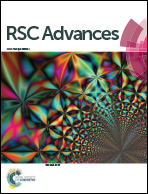Improvement of the Ar/N2 binary plasma-treated carbon passivation layer deposited on Li4Ti5O12 electrodes for stable high-rate lithium ion batteries
Abstract
In this study, nanoscale carbon overlayers, with and without nitrogen doping, have been investigated as surface passivation layers to enhance the rate capability and cycling stability of Li4Ti5O12 (LTO). As indicated by optical emission spectroscopy, Raman spectra and high resolution X-ray photoelectron spectroscopy analysis, nitrogen successfully dopes into the carbon overlayer by Ar/N2 binary plasma irradiation, owing to the interaction between the carbon overlayer and chemically reactive plasma species such as N2+ and N. In addition, the results of SEM and XPS depth profiles also prove that the N-doped carbon overlayer can effectively suppress the formation of a resistive solid–electrolyte-interface (SEI) film. The electrochemical test results demonstrate that the LTO coated with N-doped carbon overlayer (NC-overlayer/LTO) exhibits superior capacity (133 mA h g−1) and excellent stability with 91% capacity retention over 300 cycles at a high C rate (10C). The excellent electrochemical performance of NC-overlayer/LTO can be attributed to the N-doped carbon passivation layer that effectively facilitates Li+ ion diffusion and reduces internal resistance.


 Please wait while we load your content...
Please wait while we load your content...